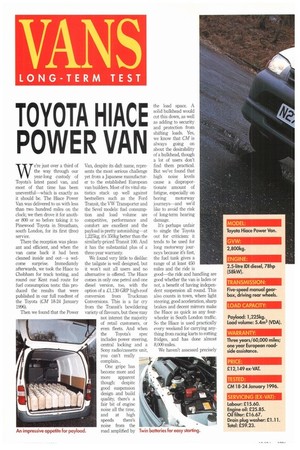VANS
Page 52

Page 53

If you've noticed an error in this article please click here to report it so we can fix it.
LONG-TERM TEST
TOYOTA HIACE POWER VAN
Were just over a third of the way through our year-long custody of Toyota's latest panel van, and most of that time has been
uneventful which is exactly as it should be. The Hiace Power Van was delivered to us with less than two hundred miles on the clock; we then drove it for another 800 or so before taking it to Pinewood Toyota in Streatham, south London, for its first (free) service.
There the reception was pleasant and efficient, and when the van came back it had been cleaned inside and out—a welcome surprise. Immediately afterwards, we took the Hiace to Chobham for track testing, and round our Kent road route for fuel consumption tests: this produced the results that were published in our full roadtest of the Toyota (CM 18-24 January 19%).
Then we found that the Power Van, despite its daft name, represents the most serious challenge yet from a Japanese manufacturer to the established European van builders. Most of its vital statistics stack up well against bestsellers such as the Ford Transit, the VW Transporter and the Sevel models: fuel consumption and load volume are competitive, performance and comfort are excellent and the payload is pretty astonishing—at 1,225kg, it's 350kg better than the similarly-priced Transit 100. And it has the substantial plus of a three-year warranty.
We found very little to dislike: the tailgate is well designed, but it won't suit all users and no alternative is offered. The Hiace comes in only one petrol and one diesel version, too, with the option of a 41,130 GRP high-roof conversion from Truclunan Conversions. This is a far cry from the Transit's bewildering variety of flavours, but these may not interest the majority of retail customers, or even fleets. And when the Toyota's spec includes power steering, central locking and a Sony radio/cassette unit, you can't really complain...
One gripe has become more and more apparent though: despite good suspension design and build quality, there's a fair bit of engine noise all the time, and at high
speeds there's L noise from the road amplified by the load space. A solid bulkhead would cut this down, as well as adding to security and protection from shifting loads Yes, we know that CM is always going on about the desirability of a bulkhead, though a lot of users don't find them practical. But we've found that high noise levels cause a disproportionate amount of fatigue, especially on boring motorway journeys—and we'd like to avoid the risk of long-term hearing damage.
It's perhaps unfair to single the Toyota out for criticism: it tends to be used for long motorway jour, neys because it's fast, the fuel tank gives a range of at least 450 miles and the ride is good—the ride and handling are good whether the van is laden or not, a benefit of having independent suspension all round. This also counts in town, where light steering, good acceleration, sharp brakes and decent mirrors make the Hiace as quick as any fourwheeler in South London traffic. So the Hiace is used practically every weekend for carrying anything from racing karts to rotting fridges, and has done almost 8,000 miles.
We haven't assessed precisely how the Toyota's fuel consumption has changed—we'd expect some improvement as the drivetrain loosens up—but in a punishing mixture of motorway and town driving the van has been returning around 30mpg. We'll do another laden run round the Kent route before the next report.
Fuel consumption is only one aspect of running cost; there's servicing, too. The Toyota's quoted annual service time for 50,000km is a competitive 5.0 hours, but we got a rude shock when we took it to Pinewood for its second service: the bill for a routine oil and filter change came to £59.23 plus VAT (a total of £69.60). Sixty quid for an oil change! We queried the figures, but they were correct. We compared this price with a Ford main dealer's quote for a diesel Transit, and it was a bit cheaper (the Ford service came to £70A0 ex-VAT). But the Transit needs a service only every 10,000 miles, while oiland-filter changes come up on the
Toyota at 4,500 mile intervals.
The final twist of the knife came when we rang up Kwik-Fit to ask ,about an oil change: they quoted a price of £13.95 (inc VAT) for the oil, a new filter and labour—less than the genuine Toyota filter alone. We'll continue to use main Toyota dealers, but if it were our van we'd be seriously tempted to take it to Kwik-Fit for an oil change every 1,500 miles... Unfortunately, the last few weeks have seen a couple of other nasty surprises, though hardly the van's fault: first, some low-life nicked the spare wheel from its cradle underneath the rear of the van (the steel 5.5Jx15 wheel alone costs .C49.38 ex-VAT).
Next, at around 7,500 miles, the radio decided to stop working—Pinewood took it out and sent it to Sony a fortnight ago, so we expect it back any day now. Then a stone cracked the windscreen at its base; the crack grew rapidly, and now the Hiace has a split screen reminiscent of an early Morris Minor, so we can expect more expense.
But once the wheel, the screen and the radio are back in place, we'll be looking forward to racking up even more miles.
E by Toby Clark
MODEL: Toyota Hiace Power Van.
GVVV: 2,800kg.
ENGINE: 2.5-litre IDI diesel, 78hp (58kW).
TRANSMISSION:
Five-speed manual gearbox, driving rear wheels.
LOAD CAPACITY: Payload: 1,225k9.
Load volume: 5.4m3 (VDA).
WARRANTY Three years/60,000 miles; one year European roadside assistance.
PRICE: £12,149 ex-VAT.
TESTED: CM 18-24 January 1996.
SERVICING (EX-VAT): Labour: £15.60.
Engine oil: £25.85. Oil filter: £16.67.
Drain plug washer: £1.11.
Total: £59.23.






























































































































